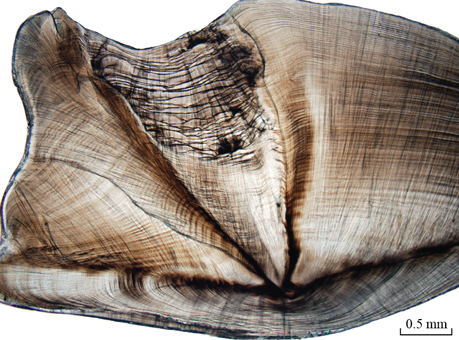Being able to tell the age of fish samples is critical in our assessments of the health of finfish stocks.
To achieve this specialised task, we have a dedicated group of fisheries scientists, who examine the otoliths (earbones) dissected from fish frames (filleted skeletons, with the heads and guts intact) donated by recreational fishers or from commercial fishers and processors.
Otoliths display growth rings, like a tree trunk, so counting the rings can reveal the age of the fish.
On average the research team analyse and age approximately 15,000 fish each year, or 300 each week. And recently the team successfully aged their 350,000th fish. This makes WA’s collection the largest in Australia.
The age estimates are generated at our marine research laboratory at Hillarys. Here our lab technicians take the otoliths, embed them in resin and take a razor thin section through the core of the otolith to expose the growth rings that are then counted using a microscope.

The otolith from Western Australia's oldest recorded fish to date - an 84-year-old female which hatched in 1929!
The information extracted from hundreds and thousands of fish can reveal a wide range of information including the age structure of wild fish populations, as well as a species’ longevity, age at sexual maturity, growth rate and variation in the level of young recruits joining a population from year to year.
The massive database of 350,000 fish ages dates back to 1990 and earlier in some cases, so any long-term changes in these characteristics are considered when developing sustainable management strategies for our finfish fisheries.
Many species from across WA are aged – from small estuarine species to large marine fish.
Western Australia’s oldest fish to date was an 84-year-old female Bight redfish, which hatched in 1929 and was caught in 2013 off Albany.
Australia’s oldest recorded snapper was caught in WA, a 41-year-old male specimen off Bunbury in 2007 (pictured).
We need the frames of key south coast and west coast species taken by recreational fishers to assist with our stock assessments, including dhufish, pink snapper, baldchin groper and red-throat emperor from the west coast, and herring, King George whiting over 35 cm and tailor from both coasts.
Although fishers should be aware that the West Coast demersal finfish closure is in effect until December 15 with demersal species in the region off limits for fishing to assist in their recovery.
To donate your frames, label them with your name and address (so we can send you information about your fish and our stock assessments) and include the date and location of your capture. In the case of a boat catch, the latitude/longitude or distance and bearing from port and the name of the port should be provided.
All information provided about your catch remains confidential – so don’t worry your secret fishing spots will be safe!
You can drop off your fish frames at our offices and participating stores. The frames can be frozen, so you can collect a few before dropping them off.